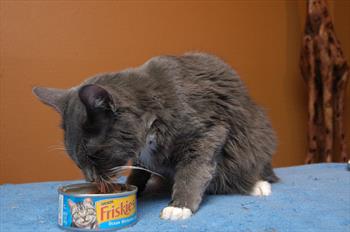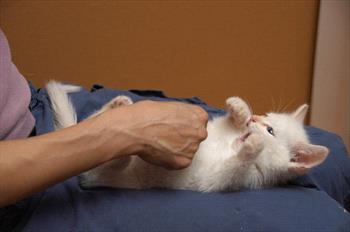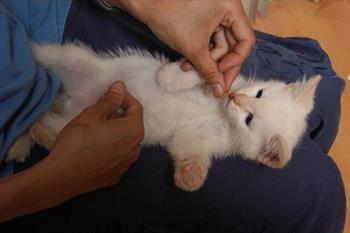Many owners struggle with trimming their cat’s nails. Nail trims, however, are important for your cat’s health and to prevent scratches of your furniture or people. Nails that become too long have the potential to cause pain, difficulty walking, and other medical issues. The goal is to make trimming your cat’s nails acceptable for your cat and easy for you. This outcome takes time, patience, and rewards.
There are several low stress handling methods that can be used to make it easier for you to trim nails, such as a towel wrap or allowing the cat to sit comfortably in a lap. Distractions such as toys or food can also be helpful during trimming.
Eating cat food

Courtesy of CattleDog Publishing
Technique for Kittens
If you have a kitten, your work starts now! Between three and nine weeks, kittens are at an important age for socialization. Now is the time to expose your kitten to other people, animals, and situations such as nail trims. Treats are the best rewards to use with your kitten. This will help them associate nail trims with a positive experience.
Kitten on back

Photo Courtesy of CattleDog Publishing
- First, figure out what position your kitten prefers. Choose a position that will keep your kitten at ease and that will allow you to deliver treats effectively. Many kittens prefer to remain standing during a nail trim.
- Get your supplies ready so that everything is prepared before you start handling your kitten, such as a towel or blanket for them to sit on, high value food rewards, nail trimmers, and styptic powder to stop bleeding if a nail is trimmed too short.
- Create a positive association with having feet handled. Touch your kitten’s feet when they are feeling relaxed and eating treats. The goal is for your kitten to feel comfortable with being touched, so discontinue touching them if they appear stressed or start to wiggle. If your kitten is uncomfortable with this, touch their feet for a shorter duration or touch a less sensitive area such as their shoulder.
Kitten on back eating treats

This kitten is being fed treats while lying on their back and getting their feet handled. This will help the kitten adapt to getting their nails trimmed and associate the experience with food. This kitten has already learned that lying on their back is a pleasant experience, however, not all kittens will enjoy lying on their back. Photo courtesy of CattleDog Publishing®.
- When you can handle their feet, then you want your kitten to associate the trimmers with a positive experience. You can try trimming one nail while they are relaxed. Give them a treat quickly after you have trimmed it. Give the kitten a break and practice again during a different session. Your kitten should not be made to hold still for all their nails to be trimmed during the first few sessions. You also do not want your kitten to be afraid of lying on your lap, thinking that their nails will be trimmed every time, so make sure you hold them there sometimes without doing anything other than loving them up.
- A slow and careful approach is necessary to avoid overwhelming your kitten. Remember, nail trims can be a positive experience! The experiences kittens have with getting their feet touched and nails trimmed when they are young set the tone for how they will react to nail trims later in life. If your kitten becomes too stressed, give them a break and engage your kitten in play. Start again at a different time when they are more comfortable.